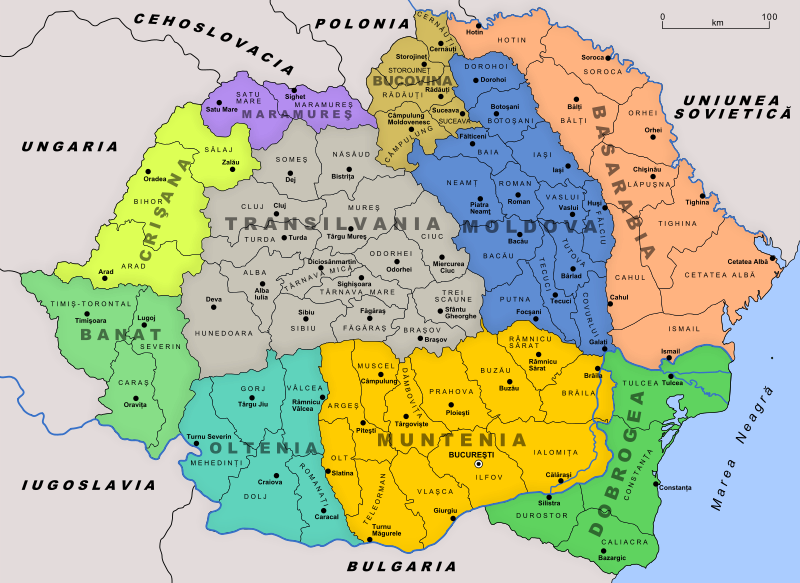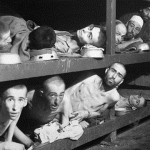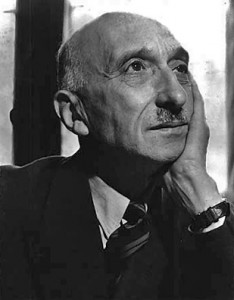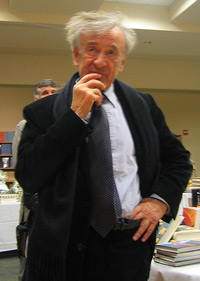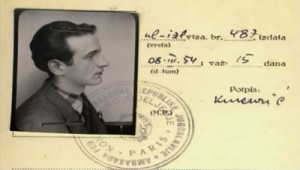The Shadowy Origins of “Night” II
Friday, August 20th, 2010
By Carolyn Yeager
copyright 2010 Carolyn Yeager
Part Two: Can the books Night and And the World Remained Silent have been written by the same author? What one critic reveals.
We know a lot about the man who calls himself Elie Wiesel from his own mouth and pen, but we know of the Lazar Wiesel born on Sept. 4, 1913 only through Miklos Grüner’s testimony, and of the author of Un di Velt Hot Gesvign (And the World Remained Silent) through the work itself. So let’s consider what we know of these two men before we look at their books.
The city of Sighet can be seen in the purple-colored Maramures district on this map of Greater Romania in the 1930’s.
Who is Elie Wiesel?
Elie Wiesel says in Night that he grew up in a “little town in Translyvania,” and his father was a well-known, respected figure within the Hasidic Orthodox Jewish community. However, Sanford Sternlicht tells us that Maramurossziget, Romania had a population of ninety thousand people, of whom over one-third were Jewish.15 Some say it was almost half. Sternlicht also writes that in April 1944, fifteen thousand Jews from Sighet and eighteen thousand more from outlying villages were deported. How many with the name of Wiesel might have been among that large group? I counted 19 Eliezer or Lazar Wiesel’s or Visel’s from the Maramures District of Romania listed as Shoah Victims on the Yad Vashem Central Database. Just think—according to their friends and relatives, nineteen men of the same name from this district perished in the camps in that one year. It causes one to wonder how many Lazar and Eliezer Wiesels didn’t perish, but became survivors and went on to write books, perhaps.
Lazare, Lazar, and Eliezer are the same name. Another variation is Leizer (prounounced Loizer). A pet version of the name is Liczu; a shortened version is Elie.16 In spite of having a popular, oft-used name, Elie Wiesel describes a unique picture of his life. The common language of the Orthodox Hasidic Jews of Sighet was Yiddish. Wiesel has said he thinks in Yiddish, but speaks and writes in French.17
In his memoir, he admits that he was a difficult, complaining child—a weak child who didn’t eat enough and liked to stay in bed.18 He comes across as definitely spoiled, the only son among three daughters.
According to Gary Henry, as well as other of Wiesel’s biographers and Wiesel himself, young Elie Wiesel was exceptionally fervent about the Hasidic way of life. He studied Torah, Talmud and Kabbalah; prayed and fasted and longed to penetrate the secrets of Jewish mysticism to such an extreme that he had “little time for the usual joys of childhood and became chronically weak and sickly from his habitual fasting.”19 His parents had to insist he combine secular studies with his Talmudic and Kabbalistic devotion. Wiesel says in Night that he ran to the synagogue every evening to pray and “weep” and met with a local Kabbalist teacher daily (Moishe the Beadle), in spite of his father’s disapproved on the grounds Elie was too young for such knowledge.
Of his elementary school studies, Wiesel writes: “[My teachers] were kind enough to look the other way when I was absent, which was often, since I was less concerned with secular studies than with holy books.” 20 And “in high school I continued to learn, only to forget.”
But his plans to become a pious, learned Jew came to an end with the deportation of Hungary’s Jews to Auschwitz-Birkenau. Wiesel has told this story both in his first book Night and in his memoir All Rivers Run to the Sea, and in many talks and lectures.
After liberation, in France, Wiesel met a Jewish scholar and master of the Talmud who gave his name simply as Shushani or Chouchani.21,22 In his memoir, Wiesel wrote:
It was in 1947 that Shushani, the mysterious Talmudic scholar, reappeared in my life. For two or three years he taught me unforgettable lessons about the limits of language and reason, about the behavior of sages and madmen, about the obscure paths of thought as it wends its way across centuries and cultures.23
Wiesel describes this person as “dirty,” “hairy,” and “ugly,” a “vagabond” who accosted him in 1947 when he was 18, and then became his mentor and one of his most influential teachers. Reportedly, when Chouchani died in 1968, Wiesel paid for his gravestone located in Montevideo, Uruguay, on which he had inscribed: “The wise Rabbi Chouchani of blessed memory. His birth and his life are sealed in enigma.” According to Wikipedia, Chouchani taught in Paris between the years of 1947 and 1952. He disappeared for a while after that, evidently spent some time in the newly-formed state of Israel, returned to Paris briefly, and then left for South America where he lived until his death.24
This could be important because it links up with Wiesel’s visits to Israel and his trip to Brazil in 1954. While the common narrative of Elie Wiesel’s post-liberation years focuses on his being a student at the Sorbonne University, Paris and an aspiring journalist, these sources reveal that he was still deeply into Jewish mysticism and involved with the Israeli resistance movement in Palestine.
Wiesel received a $16-a week-stipend from the welfare agencies.25 In addition, he worked as a translator for the militant Yiddish weekly Zion in Kamf. In 1948, at the age of 19, he went to Israel as a war correspondent for the French-Jewish newspaper L’arche, where he eventually became a correspondent for the Tel Aviv newspaper Yedioth Ahronoth.26 Shira Schoenberg at the Jewish Virtual Library puts it this way: “he became involved with the Irgun, a Jewish militant (terrorist) organization in Palestine, and translated materials from Hebrew to Yiddish for the Irgun’s newspaper […] in the 1950s he traveled around the world as a reporter.”27
The above paints a picture of a religiously-inclined personality, strongly drawn to, perhaps even obsessed with, the most mystical teachings and “secrets” of his Judaic tribe. By the age of 15, this trait was well-established. One year in detention of whatever kind (yet to be established for certain), hiding out, or other privations had no power to change these strong interests, which asserted themselves again immediately upon his “release.”
What kind of personality was Lazar Wiesel?
We only know of the Lazar Wiesel who was born on Sept. 4, 1913 through Miklos Grüner , and of the author of Un di Velt Hot Gesvign through the work itself. Note that I’m not claiming these two are one and the same.
Grüner writes in Stolen Identity28 that after the death of his father in Birkenau “after six months,” which must have been in October or early November 1944, he
went to see the friends of my father and brother, Abraham Wiesel and his brother Lazar Wiesel from Maramorossziget, [ …] Abraham was born in 1900 and his tattooed number was A-7712 and Lazar was born in 1913 and was tattooed as A-7713, whereas my father had A-11102, my brother A-11103, and I who stood after my brother finished up with the number A-11104. When they had heard the story of my father, they promised to take care of me and from then on, they became my protectors and brothers and an additional refuge …” (p. 24)
[…]
About three months had passed by, in my stage of hopelessness, I was informed by my “brothers” (Abraham and Lazar) that the Russians had managed to break through and they were on their way to liberate us from “BUNA,” Auschwitz III. (p. 25)
[…]
During the long march […] the walking became difficult and it was also hard to keep up with Abraham and Lazar. That was until I reached a place 30 km from Monowitz “Buna” called Mikolow, with a huge brickyard. Tired as I was after walking under the heavy winter conditions, I fell asleep on a pallet […] When night turned to dawn, I took my time and made my attempt to find Abraham and Lazar […] Later on I managed to find them and for the next 30 kilometres I had no problem in keeping up with them […] up to the next labor camp in Gliwice. After about three days stay in Gliwice, we were ordered to climb up onto an open railway carriage, without any given destination. […] Once again I lost Lazar and Abraham, but […] I found my old friend Karl … (p. 26)
The journey lasted about four days. On our arrival … I wobbled away to search for Abraham and Lazar. After a while, I found Lazar who told me that Abraham was having a hard time of it and he was not sure that Abraham would be able to pull through. He also mentioned that no matter what, he was going to stay with Abraham and was asking for God’s blessing. (p. 27)
[…]
When finally we were given our clothes (after showers, etc), we were registered and received new numbers that we had to memorize like children, and then we were assigned to Barrack 66. (Comment: “we” does not include Lazar and Abraham. Barrack 66 was the children’s barracks in the “small camp” at Buchenwald. Grüner was 16 yrs. old and his father had died.)
About a week later, I couldn’t believe my own eyes to see Lazar in our Block 66. He told me that Abraham had passed away four days after our arrival at Buchenwald. He made it clear that he had received special permission to join us children in Block 66, since he was so much older than us.
Five days before the liberation in April […] In our Block 66, attempts were made to get us to the main gate. The supervisor of our block, called Gustav with his red hair, indeed had managed to drive us out of the block and was determined to drive us to the gate. When we reached the middle of the yard, I pulled my trousers down (halfway), then ran off to the side and kept on running as fast as I could to the nearest block, which I believe was Block 57. I asked the man in the lower bunk if the place next to him was occupied, and I simultaneously took my position in the left hand corner of the bunk, where I remained until I was liberated.
If my memory serves me correctly, on the fourth day after my liberation, AMERICAN SOLDIERS came into the block and a picture was taken of us survivors of the Holocaust. […] This picture has become famous all over the world as a memory of the Holocaust.29 After a change of clothing and a medical examination, I went to look for Lazar, but unfortunately I could not find him anywhere. (p 28)
On page 30, Grüner writes: “When the liberating American soldiers came into our barrack, they discovered a block full of emaciated people lying in bunks. In the next minute a flashlight from a camera went off, and I without my knowing, was caught on the picture forever.”
Grüner never saw Lazar Wiesel again, since, according to him, Lazar was sent to France, and Grüner to a sanatorium in Switzerland. When Grüner was contacted in 1986 about meeting the Nobel Prize winner Elie Wiesel, he thought he was going to be meeting his old friend Lazar Wiesel.
What does Un di Velt Hot Gesvign tell us about Eliezer Wiesel?
Naomi Siedman, Professor of Jewish Culture at Graduate Theological Union, is one of the few academics to delve into Wiesel’s early writings with a critical spirit. Her very controversial essay “Elie Wiesel and the Scandal of Jewish Rage,”30 written in 1996, one year after the publication of Wiesel’s memoir All Rivers Run to the Sea, examines several passages in Night and compares them to passages in the Yiddish original. Among the relevant issues she brings up is this one:
Let me be clear: the interpretation of the Holocaust as a religious theological event is not a tendentious imposition on Night but rather a careful reading of the work.
In other words, Night presents the Holocaust as a religious event, rather than historical. In contrast, Siedman found that the Yiddish version, Un di Velt, published two years prior to the publication of Night, was similar to all others in the “growing genre of Yiddish Holocaust memoirs” which were praised for their “comprehensiveness, the thoroughness of (their) documentation not only of the genocide but also, of its victims.” Un di Velt Hot Gesvign was published as volume 117 of Mark Turkov’s Dos poylishe yidntum (Polish Jewry) in Buenos Aires.
Siedman refers to a reviewer of the mostly Polish Yiddish series when she writes:
For the Yiddish reader, Eliezer (as he is called here) Wiesel’s memoir was one among many, valuable for its contributing an account of what was certainly an unusual circumstance among East European Jews: their ignorance, as late as the spring of 1944, of the scale and nature of the Germans’ genocidal intentions. The experiences of the Jews of Transylvania may have been illuminating, but certainly none among the readers of Turkov’s series on Polish Jewry would have taken it as representative. As the review makes clear, the value of survivor testimony was in its specificity and comprehensiveness; Turkov’s series was not alone in its preference. Yiddish Holocaust memoirs often modeled themselves on the local chronical (pinkes ) or memorial book (yizker-bukh ) in which catalogs of names, addresses, and occupations served as form and motivation. It is within this literary context, against this set of generic conventions, that Wiesel published the first of his Holocaust memoirs.
Siedman continues that “Un di velt has been variously referred to as the original Yiddish version of Night and described as more than four times as long; actually, it is 245 pages to the French 158 pages.” But the “four times as long” was referring to the original 862 pages that Turkov cut down to 245. Siedman reminds us that Wiesel had earlier described his writing of the Yiddish with no revisions, “frantically scribbled, without reading.” She says this, and Wiesel’s complaint that the original manuscript was never returned to him, are “confusing and possibly contradictory.” She then writes:
What distinguishes the Yiddish from the French is not so much length as attention to detail, an adherence to that principle of comprehensiveness so valued by the editors and reviewers of the Polish Jewry series. Thus, whereas the first page of Night succinctly and picturesquely describes Sighet as “that little town in Transylvania where I spent my childhood,” Un di velt introduces Sighet as “the most important city [shtot] and the one with the largest Jewish population in the province of Marmarosh.” 31 The Yiddish goes on to provide a historical account of the region: “Until, the First World War, Sighet belonged to Austro-Hungary. Then it became part of Romania. In 1940, Hungary acquired it again.”
The great length of the original was no doubt due to the extensive detail it contained about the events, places and people that were the subject of the narrative. Despite the fact that descriptive detail is not a characteristic in any of Wiesel’s known writing, he would never have been able to write all that detail in two weeks in a ship’s cabin, relying only on his memory. He even says he saw no one during that time and cut himself off from everything. In the writing style of Elie Wiesel that we’re familiar with, what could he possibly have said to fill up 862 pages? Impossible!
Another point made by Siedman: And while the French memoir is dedicated “in memory of my parents and of my little sister, Tsipora,” the Yiddish (book) names both victims and perpetrators: “This book is dedicated to the eternal memory of my mother Sarah, father Shlomo, and my little sister Tsipora — who were killed by the German murderers.” 32 The Yiddish dedication is an accusation from a very angry Jew who is assigning exact blame for who was responsible. In addition, this brings to mind the fact that Elie Wiesel’s youngest sister was named Judith at birth, not Tsipora (according to his sister Hilda’s testimony).
Siedman says the effect of this editing from the Yiddish to the French was:
…to position the memoir within a different literary genre. Even the title Un di velt hot geshvign signifies a kind of silence very distant from the mystical silence at the heart of Night. The Yiddish title (And the World Remained Silent) indicts the world that did nothing to stop the Holocaust and allows its perpetrators to carry on normal lives […] From the historical and political specificities of Yiddish documentary testimony, Wiesel and his French publishing house fashioned something closer to mythopoetic narrative.
Myth and poetry … from a very historical and political original testimony. Wiesel attempted to explain this in his memoir by describing his French publisher’s objections to his documentary approach: “Lindon was unhappy with my probably too abstract manner of introducing the subject. Nor was he enamored of two pages (only two pages?) which sought to describe the premises and early phases of the tragedy. Testimony from survivors tends to begin with these sorts of descriptions, evoking loved ones as well as one’s hometown before the annihilation, as if breathing life into them one last time.” 33 Just how convincing that is I leave up to the reader.
The most controversial part of Siedman’s essay is about the Jewish commandment for revenge against one’s enemies. The author of the Yiddish writes that right after the liberation at Buchenwald:
Early the next day Jewish boys ran off to Weimar to steal clothing and potatoes. And to rape German girls [un tsu fargvaldikn daytshe shikses]. The historical commandment of revenge was not fulfilled.” 34
This reflects the same angry, stern Jew who demands the Jewish law of revenge upon one’s enemies be followed. He does not consider “raping German girls” to be sufficient revenge; thus he says the historical commandment was not fulfilled. In the French and English, it was softened to: “On the following morning, some of the young men went to Weimar to get some potatoes and clothes—and to sleep with girls. But of revenge, not a sign.”35 Siedman comments on this passage:
To describe the differences between these versions as a stylistic reworking is to miss the extent of what is suppressed in the French. Un di velt depicts a post-Holocaust landscape in which Jewish boys “run off” to steal provisions and rape German girls; Night extracts from this scene of lawless retribution a far more innocent picture of the aftermath of the war, with young men going off to the nearest city to look for clothes and sex. In the Yiddish, the survivors are explicitly described as Jews and their victims (or intended victims) as German; in the French, they are just young men and women. The narrator of both versions decries the Jewish failure to take revenge against the Germans, but this failure means something different when it is emblematized, as it is in Yiddish, with the rape of German women. The implication, in the Yiddish, is that rape is a frivolous dereliction of the obligation to fulfill the “historical commandment of revenge”; presumably fulfillment of this obligation would involve a concerted and public act of retribution with a clearly defined target. Un di velt does not spell out what form this retribution might take, only that it is sanctioned — even commanded — by Jewish history and tradition.
The final passage that Siedman compares is the famous ending of Night. The Yiddish version presents not only a longer narrative, but a radically different person who emerges from his camp experience at the time of liberation.
Three days after liberation I became very ill; food-poisoning. They took me to the hospital and the doctors said that I was gone. For two weeks I lay in the hospital between life and death. My situation grew worse from day to day.
One fine day I got up—with the last of my energy—and went over to the mirror that was hanging on the wall. I wanted to see myself. I had not seen myself since the ghetto. From the mirror a skeleton gazed out. Skin and bones. I saw the image of myself after my death. It was at that instant that the will to live was awakened. Without knowing why, I raised a balled-up fist and smashed the mirror, breaking the image that lived within it. And then — I fainted… From that moment on my health began to improve. I stayed in bed for a few more days, in the course of which I wrote the outline of the book you are holding in your hand, dear reader.
But—Now, ten years after Buchenwald, I see that the world is forgetting. Germany is a sovereign state, the German army has been reborn. The bestial sadist of Buchenwald, Ilsa Koch, is happily raising her children. War criminals stroll in the streets of Hamburg and Munich. The past has been erased. Forgotten. Germans and anti-Semites persuade the world that the story of the six million Jewish martyrs is a fantasy, and the naive world will probably believe them, if not today, then tomorrow or the next day.
So I thought it would be a good idea to publish a book based on the notes I wrote in Buchenwald. I am not so naive to believe that this book will change history or shake people’s beliefs. Books no longer have the power they once had. Those who were silent yesterday will also be silent tomorrow. I often ask myself, now, ten years after Buchenwald : Was it worth breaking that mirror? Was it worth it? 36
This entire passage sounds nothing like Elie Wiesel, or anything he has written. It is matter of fact, not indulging in self-pity but addressing the reality of the situation with a cynical eye. The author is concerned with the traditional problems of Jews, as he sees it, and their welfare. His “witness” as a survivor is not mystical or universalized, but is about assessing blame. His depiction of smashing the mirror that holds his dead-looking image, and how that expression of powerful anger and life-affirmation revived him, is convincing. Right away, he wants to write about his experience, and he begins. Anger and “putting it all down” is the way out of depression and listlessness.
Yet the author and editors of Night have removed almost all of this and end very differently:
One day I was able to get up, after gathering all my strength. I wanted to see myself in the mirror hanging from the opposite wall. I had not seen myself since the ghetto.
From the depths of the mirror, a corpse gazed back at me.
The look in his eyes, as they stared into mine, has never left me.37
No anger. No recuperation or recovery possible for this character. No closure. Elie Wiesel leaves us in Night with the image of death, and for the rest of his life he will pour it out on the world through his writings. This is his legacy; the Holocaust never ends.
Siedman comments on these two endings:
There are two survivors, then, a Yiddish and a French—or perhaps we should say one survivor who speaks to a Jewish audience and one whose first reader is a French Catholic. The survivor who met with Mauriac labors under the self-imposed seal and burden of silence, the silence of his association with the dead. The Yiddish survivor is alive with a vengeance and eager to break the wall of indifference he feels surrounds him.
Naomi Siedman intends the “two survivors” to be taken symbolically, as she is a “respected” Jewish academic who does not question the Holocaust story, and does not question (publicly at least) the authenticity of Elie Wiesel as the author of the Yiddish 862-page And the World Remained Silent, no matter what difficulties are encountered. As she continues in this essay, she posits Francois Mauriac’s powerful influence on Elie Wiesel as the way of explaining the further shortening and redirection of the focus of the original text. This is not my position, so I don’t find it profitable to seek for the origins of Night in Mauriac’s Catholic/Christian views. I believe there are sufficient grounds to consider a different authorship for Un di Velt Hot Gesvign, and that neutral-minded, critical thinkers who have an interest in this subject would not object to studying it from this angle.
However the grounds for doing so have not been exhausted by these two essays, so I will continue with a summing up in Part Three.
Endnotes:
15) Sanford Sternlicht, Student Companion to Elie Wiesel, Greenwood Press, Westport, CT, 2003, p. 3.
16) Ibid.
17) First Person: Life & Work. http://www.pbs.org/eliewiesel/life/index.html
18) All Rivers Run to the Sea, p. 9
19) First Person: http://www.pbs.org/eliewiesel/life/henry.html
20) Rivers, p. 20
21) http://www.jewishvirtuallibrary.org/jsource/biography/Wiesel.html
22) http://en.wikipedia.org/wiki/Monsieur_Chouchani
23) Rivers, p. 121
24) Wikipedia, Chouchani
25) http://en.wikipedia.org/wiki/Night_(book) Miklos Grüner says his 32-year-old friend Lazar Wiesel was given an apartment and an income because he had travelled with the orphans to France, under special permission. (see Stolen Identity by Grüner, printed in Sweden, 2007)
26) Wiki/Night
27) Jewish virtual library, ibid.
28) http://www.scribd.com/doc/33182028/STOLEN-IDENTITY-Elie-Wiesel
29) Grüner is speaking of Block 56, where what was to become the “famous Buchenwald liberation photograph” was taken by an American military photographer on April 16, 1945, five days after liberation. See our analysis of this photo under “The Evidence” on the menu bar.
30) “Elie Wiesel and the Scandal of Jewish Rage,” Seidman, ibid.
31) Eliezer Vizel, Un di velt hot geshvign (Buenos Aires, 1956), p. 7
32) Un di velt, n.p.
33) Rivers, p. 319
34) Un di velt, 244.
35) Night, 120.
36) Un di velt, 244-45
37) Night, 120.
Category Featured | Tags: Tags: Hasidic Jews, Miklos Grüner, Naomi Siedman, Night, Romania, Shushani/Chouchani, Sighet, Un di Velt Hot Gesvign, Zion in Kamf,
Social Networks: Facebook, Twitter, Google Bookmarks, del.icio.us, StumbleUpon, Digg, Reddit, Posterous.

